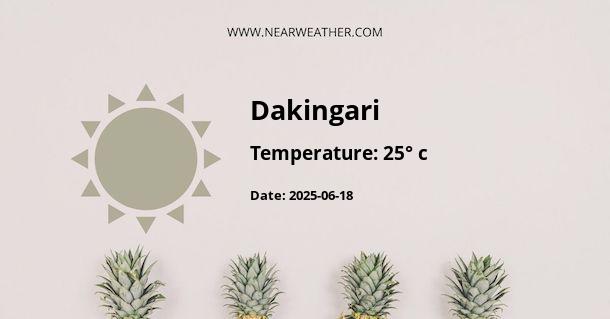Dakingari, Nigeria: Climate and Weather Year Round
Dakingari is a small town located in the Kebbi State of Nigeria. It is situated in the northwestern part of the country and experiences a tropical savanna climate throughout the year. The town is known for its diverse culture, historical sites, and vibrant agricultural practices. Understanding the climate and weather patterns in Dakingari is essential for residents and visitors alike. In this article, we will explore the climate and weather conditions in Dakingari throughout the year, providing detailed information about temperature, precipitation, and other climatic factors. Let's dive in!
Temperature
Dakingari experiences hot temperatures throughout the year, with slight variations between seasons. The hottest months are typically March and April, where temperatures can reach as high as 38°C (100°F). The coolest months are December and January, with average temperatures ranging from 18°C (64°F) to 25°C (77°F). Overall, the average annual temperature in Dakingari is around 27°C (81°F).
During the dry season, which lasts from November to April, temperatures can soar due to the absence of cloud cover and limited rainfall. This period is characterized by hot and dry weather, with temperatures often exceeding 35°C (95°F) during the day. The harmattan winds, which blow from the Sahara Desert, can also contribute to the high temperatures and dryness during this season.
In contrast, the wet season in Dakingari occurs from May to October. During this period, temperatures are relatively cooler, ranging from 24°C (75°F) to 32°C (90°F). The presence of rainfall and increased cloud cover helps to moderate the heat, making the weather more pleasant compared to the dry season.
Precipitation
Dakingari receives the majority of its rainfall during the wet season. The wettest months are typically August and September, with an average rainfall of around 200mm (8 inches) per month. However, rainfall can vary significantly from year to year, and occasional heavy downpours are not uncommon.
During the dry season, precipitation is minimal, with little to no rainfall occurring between November and April. This prolonged dry spell contributes to the arid conditions experienced during this period. It's worth noting that Dakingari lies on the fringe of the Sahel region, which is characterized by a semi-arid climate.
It is important to be prepared for both the wet and dry seasons in Dakingari. During the wet season, heavy rainfall can lead to flooding in some areas, so it is advisable to monitor weather forecasts and take necessary precautions. In contrast, the dry season brings with it the risk of bushfires due to the dry vegetation. Local authorities often issue warnings and guidelines to prevent and manage such incidents.
Humidity and Winds
Dakingari experiences high humidity levels throughout the year, especially during the wet season. The humidity can range from 60% to 90%, making the weather feel more oppressive and sticky. The presence of moisture in the air can also contribute to the formation of thunderstorms during the wet season.
The harmattan winds, originating from the Sahara Desert, have a significant impact on the climate of Dakingari. These dry and dusty winds blow southwards across the region between December and February. The harmattan winds can result in reduced visibility, increased dust levels, and a drop in temperatures during this period.
Climate Extremes
While Dakingari generally experiences a tropical savanna climate, extreme weather events can occur from time to time. These events include heavy rainfall, thunderstorms, strong winds, and occasional heatwaves.
It is important to stay informed about weather conditions and heed any warnings or advisories issued by local authorities. Being prepared for extreme weather events can help ensure the safety and well-being of residents and visitors in Dakingari.
Conclusion
Dakingari, Nigeria, has a tropical savanna climate characterized by hot temperatures year-round. The dry season, lasting from November to April, brings scorching heat and minimal rainfall, while the wet season, occurring from May to October, provides relief with cooler temperatures and increased precipitation. Understanding the climate and weather patterns in Dakingari is essential for planning activities, cultivating crops, and ensuring the safety of individuals in the region.
A - Dakingari's Latitude is 11.645110 & Longitude is 4.060460.
A - Weather in Dakingari is 25° today.
A - Climate Conditions in Dakingari shows few clouds today.
A - Humidity in Dakingari is 14% today.
A - Wind speed in Dakingari is 15.08 km/h, flowing at 34° wind direction. today.
